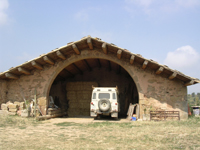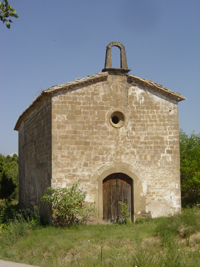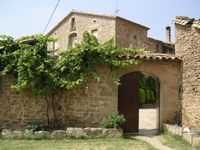el Solsonès |
Can Postils
Navès (Solsonès)The farmhouses in the region of el Solsonès
The region known as el Solsonès is exceedingly agricultural, with cattle farming land forestlands, it is a rural habitat where architectonical, and artistic manifestations have been stamped since the middle ages. The scattered population in a large number of farmhouses dispersed strategically over a wide territory, covered with dense and varied vegetation, has the benefit of a natural habitat of incalculable worth. It is an area densely covered with farmhouses similar to el Berguedà, el Bages and l'Anoia. This density tends to thin out in the adjacent regions to the southwest and northeast, such as la Segarra, la Noguera i l'Alt Urgell. An important number of these farmhouses are still active, which is not such a frequent phenomenon in other regions of Catalunya La comarca del Solsonès és una àrea amb una important densitat de masies, la qual es troba situada en una zona on les seves comarques colindants tendeixen a minvar aquesta implantació sobretot les limítrofes a la part sud-oest i nord-oest com la Segarra, la Noguera i l'Alt Urgell. Amb més intensitat de població disseminada, però no amb escreix hi ha el Berguedà, el Bages i l'Anoia. Aquesta comarca és un referent del món de la pagesia a la zona de la Catalunya Central. where these building have taken on new uses and activities.
It is easy to perceive from the general setting of the farmhouse that the peculiarities of each area or region are present. These peculiarities are often due to initiatives of the master builder of the area, whose techniques and expertise of a determined architectural type were limited to the area in which he worked: these techniques were implanted in the region and in time were transformed in accordance with the evolution of the farm building.
One of the important factors that characterised the building was the geology of the region, that is to say, the type of stone available: the outside finishing in many farmhouses is stone (58% in el Solsonès), which the master builder put in place depending on the type, shape, texture and colour. Certain areas of .
El Solsonès are made up of red sandstone, giving a reddish-brown appearance to the outside of some of the farmhouses.
The farmhouses in el Solsonès predominantly have two sided roofs, which generally drain to the sidewalls and four sided structures are extremely rare (less than 1%). Usually a four-sided roof will be found on very large houses with much more distinguished appearances.
The front facade is the most relevant element in showing the architectural character of each farmhouse. In el Solsonès ‘full' predominates over ‘empty': the openings in the walls for the windows are not large. Covered galleries open to the outside are not usually found (which is typical la Garrotxa). If, in some of the buildings, there are larger windows than usual situated at the front of the façade then these are usually closed to the outside: the gallery space forms part of the living room, as seen at la Sala de Linya and les Planes de Besora (Navès).
Another important characteristic to underline appears in en many farm buildings. In the front facade which is usually the only wall which contains openings, the ‘full' and ‘empty' surfaces are more balanced out (to the extent of 50% each). The technique usually consists of two or three openings crowned with a half pointed arch, as we can see in the porch of la Casanova (Pinell) and the porch of la Codina (Pinell).
On the other hand, we also have examples of single larger arches, such as that at Cal Soler (Pinós), the porch of Cal Serramorena (Riner) and the porch of les Comes d'Olius (Solsona).
Other typical elements to el Solsonès are the bulwark and the chapel. The bulwark was a wall which formed a rectangular enclosure to the sides and from of the farmhouse. It usually had a fine gateway, arched with wedges of stone, although there are some with flat lintels made from a single large stone slab or with a small two-sided roof.Joan Curós i Vilà
Universitat Politècnica de Catalunya
Cal el Soler
Pinós (Solsonès)
Sant Tirs
Pinell de Solsonès (Solsonès)
Cal Cabot
Riner (Solsonès)



